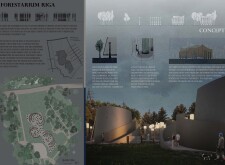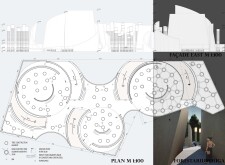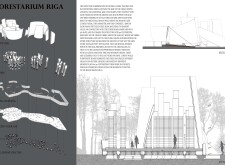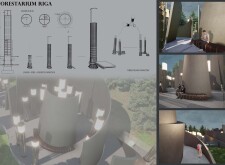5 key facts about this project
At the core of the Forestarium Riga project is its representation of nature through architecture. The design envelopes visitors in a narrative that mirrors the essence of the forest, ensuring that experiences within the space foster reflection and appreciation for the ecosystem. This project serves multiple functions, including areas designated for contemplation, social gatherings, and quiet personal reflection, all tailored to enhance interaction with the landscape. Visitors are guided through a series of thematic zones that cater to diverse emotional and social experiences, creating a multifaceted engagement with the environment.
The architectural layout comprises three interconnected circles, each designed for specific activities. This configuration allows for an intuitive flow of movement while accentuating the shared experience with the adjacent forest. Furthermore, the design incorporates paths that create a thoughtful journey through various spaces, inviting exploration and discovery. The circular pathways encourage visitors to engage with different environments, whether they seek solitude or the company of others.
Materiality plays a significant role in the overall project, highlighting a commitment to sustainability and durability. Corten steel is used extensively within the structural framework, providing both strength and an organic aesthetic as it develops a natural patina over time. Concrete serves as another essential material, creating robust foundations and versatile surfaces that support the design’s varied functions. Steel connections enhance structural integrity while allowing for creative design flexibility. The thoughtful inclusion of glazed elements ensures that natural light penetrates interior spaces, offering visual connections to the outdoor environment and framing views of the lush forest landscape.
Unique design approaches within the Forestarium project further emphasize its commitment to merging architecture with nature. The curvilinear forms adopted in the design mimic the organic shapes found in the forest, creating an inviting atmosphere that feels cohesive with the natural world. This design choice not only enhances the aesthetic appeal but also facilitates emotional engagement, allowing users to experience the space in a more profound way. The careful organization of themed spaces within the circles also supports a varied use of the site, catering to different needs—from quiet reflection to communal events.
Moreover, the project encourages thoughtful interaction with the landscape, promoting a dialogue between the architecture and its setting. Each circular zone is designed to evoke specific moods and facilitate various social interactions, providing both intimacy and openness. These intentioned features allow users to navigate their emotional landscape while being enveloped by the rich sensory experience of the outdoor environment.
In summary, the Forestarium Riga project exemplifies how architecture can thoughtfully respond to its context, fostering a relationship between the built environment and nature. By exploring elements such as architectural plans, architectural sections, and architectural designs, readers can gain deeper insights into the innovative ideas that shape this project. Engaging with the presentation of this architectural endeavor is encouraged for those seeking to understand not just the physical structure, but also the underlying principles that forge its identity.


























